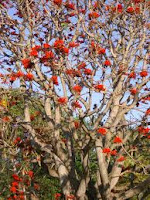GIANT PUFFBALL, CALVATIA GIGANTEA
The giant puffball mushroom can be found in Europe including Britain North America . If you see a mushroom the size of a football in a field or on the edges of woodland then it is probably the giant puffball which was once named Langermannia gigantea. Its correct Latin name is now Calvatia gigantea. They can grow to enormous sizes, with the largest British specimen being 64 inches (162 centimetres) in circumference and a reported on from the US
 The young immature puffball is edible and has a rich, earthy, nutty taste, although some believe it to be bland, only taking on the flavours of the foodstuff it is cooked with. They are delicious fried in butter and good in an omelette. Some say that they can be used instead of tofu or aubergines, but they are good chopped in any recipe that calls for mushrooms. You should only eat giant puffballs which have no gills and have not formed spores. When this happens they turn a pale yellow colour and as they mature they become yellow-brown. They have to have solid white flesh in their interior for them to be edible. In the
The young immature puffball is edible and has a rich, earthy, nutty taste, although some believe it to be bland, only taking on the flavours of the foodstuff it is cooked with. They are delicious fried in butter and good in an omelette. Some say that they can be used instead of tofu or aubergines, but they are good chopped in any recipe that calls for mushrooms. You should only eat giant puffballs which have no gills and have not formed spores. When this happens they turn a pale yellow colour and as they mature they become yellow-brown. They have to have solid white flesh in their interior for them to be edible. In the When they have formed spores and are ready to ejaculate them, a single drop of rain will trigger the spores’ release. Children love kicking them to release the powdery spores, and as they are inedible at this time it isn’t a waste of a mushroom.
Native Americans used the spores for wound healing as they help blood to coagulate and it is believed that they have antiseptic properties.
Back in the 1960s a substance named calvacin was isolated from giant puffballs and proved to have anti-tumour properties in vitro. When experiments on animals became increasingly used this substance was tested on lab rats but unfortunately. Although it did kill the cancerous cells and the tumour it had bad side effects and caused anorexia, acute liver failure, muscle inflammation and bleeding from the lungs. Some rats died within two days of being subjects of the experiment.
However in 2008 new research was conducted into the substances which can be found in these mushrooms and three were found to be present which had not been reported in mushrooms previously: Methyl anthranilate, Methyl N N-dimethylanthranilate and Methyl N-methylanthranilate. (“Volatile Constituents of the Giant Puffball Calvatia gigantea” by John C. Leffingwell and E. D. Alford in Leffingwell Reports Vol. 4 March 2011 .)
Although these mushrooms can be found in most of Europe they are a cause for conservation concern in Norway Lithuania Poland
In Britain
 Apart from eating them, our ancestors used them for tinder as this piece of information from the 16th century British herbalist, John Gerard, shows.
Apart from eating them, our ancestors used them for tinder as this piece of information from the 16th century British herbalist, John Gerard, shows. “In divers parts of England
They have similar nutrition qualities as other mushrooms including morels, chanterelles and the oyster mushrooms.





















